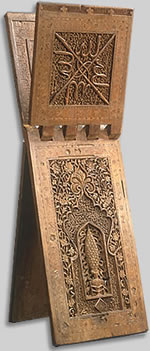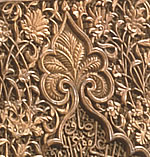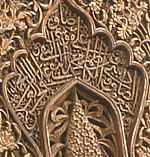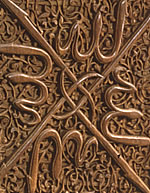| |
|
 |
|
 |
Qur’an Stand
Hasan ibn Sulaiman al-Isfahani
Iran or Central Asia, A.H. Dhu al-Hijja 761/A.D. October–November
1360
Wood, carved and inlaid
The Metropolitan Museum of Art, New York, Rogers Fund, 1910 (10.218)
cat. 176
© 1990 The Metropolitan Museum of Art, New York
[click on top image for full object view] |
|
  |
 |
The Qur’an stand, or rahla, was a
common furnishing in mosques and other places of worship.
This example, with its richly carved calligraphy and lush foliate
designs, bears the signature of its maker as well as its date of
manufacture and the name of the patron who commissioned it for a
madrasa, or theological college. |
|
 |
 |
|
The graceful inscription above the cypress tree calls for blessings
upon the prophet and the Twelve Imams, the latter suggesting that
the Qur’an stand was commissioned for a Shi‘ite school. |
|
 |
 |
The upper sections of the stand are
decorated with the word “Allah” repeated four times
so that the initial letters alif interlock to create an
X-shaped design; this is set against a deeply carved arabesque ground.
Two rahlas support copies of the Qur'an in a painting of a tent
mosque on page 3 of this section (The Mongols and Islam). |
|
 |
 |
 |
 |
 |
|
|
|


